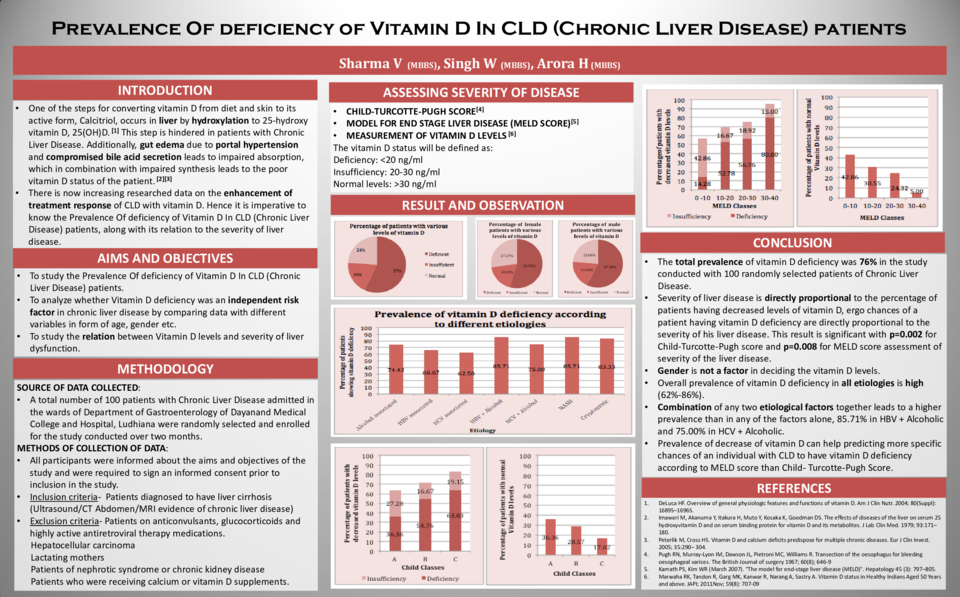Abstract
Title
Prevalence of deficiency of Vitamin D in CLD (Chronic Liver Disease) patients.
Introduction
One of the steps for converting vitamin D from diet and skin to its active form, Calcitriol, occurs in liver by hydroxylation it to 25-hydroxy vitamin D, 25(OH)D. This step is hindered in patients with Chronic Liver Disease. Additionally, gut edema due to portal hypertension and compromised bile acid secretion leads to impaired absorption, which in combination with impaired synthesis leads to the poor vitamin D status of the patient.
There is now increasing researched data on the enhancement the treatment response of CLD with vitamin D. Hence it is imperative to know the Prevalence of deficiency of Vitamin D in CLD (Chronic Liver Disease) patients, along with its relation to the severity of liver disease.
Aims and objectives
Study the relationship between vitamin D deficiency and CLD in terms of
- Prevalence
- Independence of risk factor w.r.t other variables
- Effect of severity of CLD
Methodology
A total number of 100 patients with Chronic Liver Disease admitted in the wards of Department of Gastroenterology of Dayanand Medical College and Hospital, Ludhiana were randomly selected enrolled for the study conducted over two months. All participants were informed about the aims and objectives of the study and were required to sign an informed consent prior to inclusion in the study. Serum vitamin D levels of the patients were determined and Child-Turcotte-Pugh Score and MELD score were calculated. Correlational analysis of data collected was done
Result and Conclusions
- The total prevalence of vitamin D deficiency was 76% in the study conducted with 100 randomly selected patients of Chronic Liver Disease.
- Prevalence of vitamin D deficiencies in the patients with CLD falling under Child class A is 63.64%, Child class B is 71.43% and Child class C is 82. 98%.
- Prevalence of vitamin D deficiencies in the patients with CLD falling under MELD class 0-10 are 57.14%, MELD class 10-20 are 69.45%, MELD class 20-30 are 75.68% and MELD class >30 are 85%.
- Out of 100 patients, 57 showed vitamin D deficiency, 19 showed insufficiency and 24 had normal levels of vitamin D.
- Severity of liver disease is directly proportional to the percentage of patients having decreased levels of vitamin D, ergo chances of a patient having vitamin D deficiency are directly proportional to the severity of his liver disease. This result is significant with p=0.002 for Child-Turcotte-Pugh score and p=0.008 for MELD score assessment of severity of the liver disease.
- Gender is not a factor in deciding the vitamin D levels.
- Overall prevalence of vitamin D deficiency in all etiologies is high (62%-86%).
- Prevalence of vitamin D deficiency in Alcoholic related CLD is 74.42%, HBV related is 66.67%, HCV related 62.50%, NASH is 85.71% and cryptogenic is 83.33%.
- Combination of any two etiological factors together leads to a higher prevalence than in any of the factors alone, 85.71% in HBV + Alcoholic and 75.00% in HCV + Alcoholic.
- Prevalence of decrease of vitamin D can help predicting more specific chances of an individual with CLD to have vitamin D deficiency according to MELD score than Child- Turcotte-Pugh Score.






